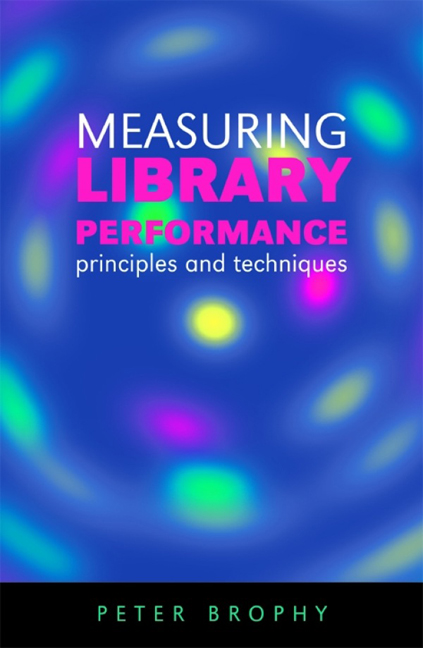Book contents
- Frontmatter
- Contents
- List of figures
- List of tables
- Preface
- Acronyms and abbreviations
- 1 Background
- 2 Theoretical considerations
- 3 User satisfaction
- 4 Impact on users
- 5 Social and economic impact
- 6 Inputs
- 7 Processes
- 8 Outputs
- 9 Staff
- 10 Infrastructure
- 11 Services for all
- 12 Benchmarking
- 13 The balanced scorecard
- 14 Standards
- Appendix 1 Data collection methods
- Appendix 2 The analysis of data
- Appendix 3 The presentation of results
- Index
- Frontmatter
- Contents
- List of figures
- List of tables
- Preface
- Acronyms and abbreviations
- 1 Background
- 2 Theoretical considerations
- 3 User satisfaction
- 4 Impact on users
- 5 Social and economic impact
- 6 Inputs
- 7 Processes
- 8 Outputs
- 9 Staff
- 10 Infrastructure
- 11 Services for all
- 12 Benchmarking
- 13 The balanced scorecard
- 14 Standards
- Appendix 1 Data collection methods
- Appendix 2 The analysis of data
- Appendix 3 The presentation of results
- Index
Summary
■ Introduction
This book has deliberately chosen to put the spotlight on effectiveness, outcome and impact measures in its early chapters, reflecting a concern shared by most professionals to show how much good a library does. However, there are many occasions when it is important to measure inputs – resources which contribute towards the delivery of the service itself; processes – the work done to transform the raw inputs into useful products and services; and outputs – those things, including the intangibles, which are produced. The next three chapters focus on these topics.
■ The library profile
One vehicle for presenting input measures is the ‘library profile’ and many reports and studies use this approach. In essence the idea is to draw a picture of the library in terms of what resources it has to draw on. These include stock held, contracts for access to information sources, buildings, staff, IT equipment, financial resources and various types of infrastructure. There is always a temptation in presenting such data to imply that ‘the bigger the better’. So a larger building, it is implied, is better than a smaller one. A larger bookstock is better than a limited one. All other things being equal, these statements are probably true but it is rare for all things to be equal. Apart from anything else, the purposes of the library and the purposes for which the resources are held will differ over time and between organizations.
■ Library statistics
When measuring inputs, processes and outputs it is common to make use of quantitative (i.e. statistical) data. Indeed, this is so much the norm that it may be taken almost for granted. Such data may be presented in terms of the individual branch, the individual library, a sector or by some other grouping.
Most libraries issue an annual report of some kind, which contains much data of this type. For example the British Library's Annual Report contains a section headed ‘Statistics’ (the 2004–5 version is at www.bl.uk/about/annual/2004to2005/pdf/statistics.pdf).
Information
- Type
- Chapter
- Information
- Measuring Library Performanceprinciples and techniques, pp. 90 - 105Publisher: FacetPrint publication year: 2006
